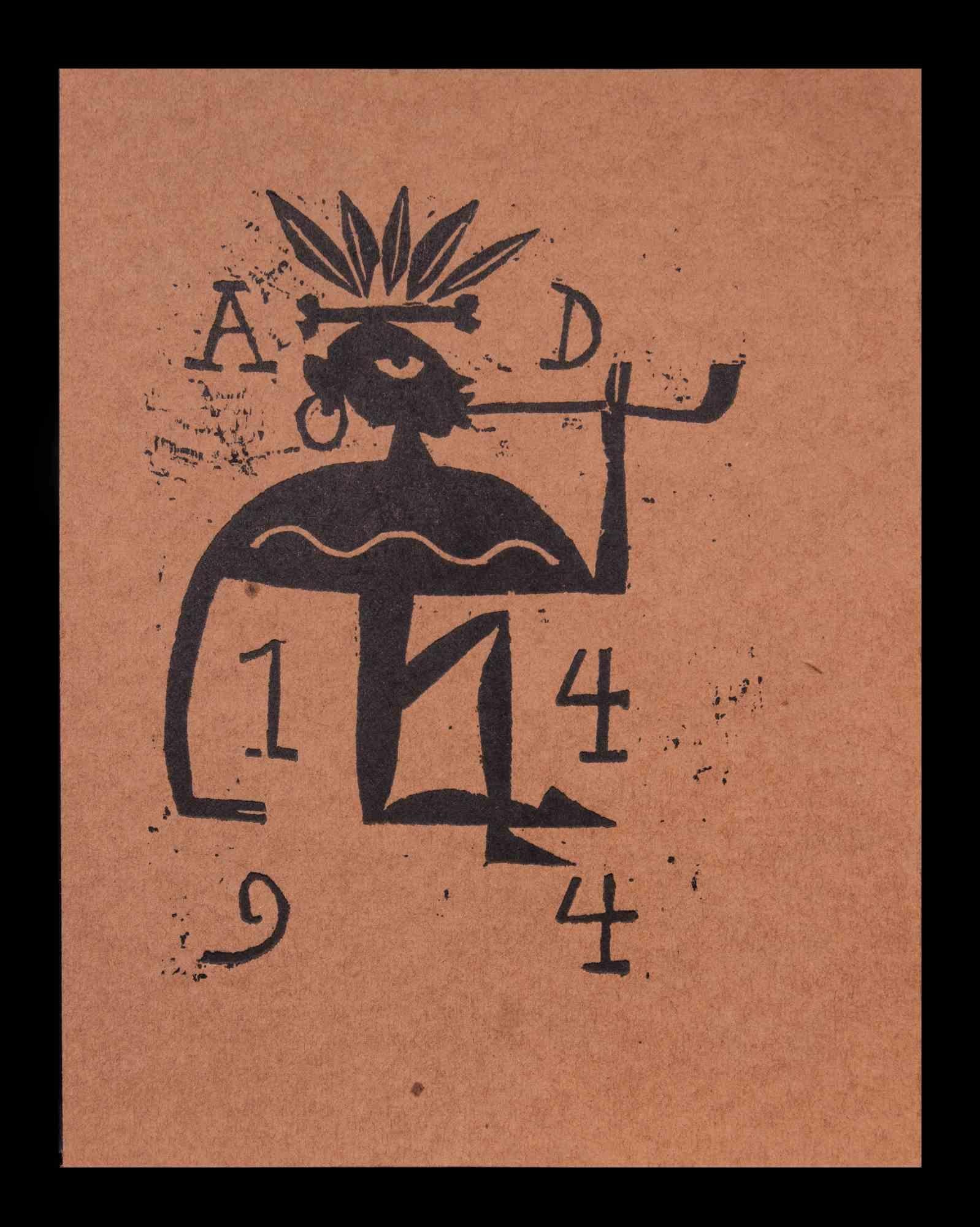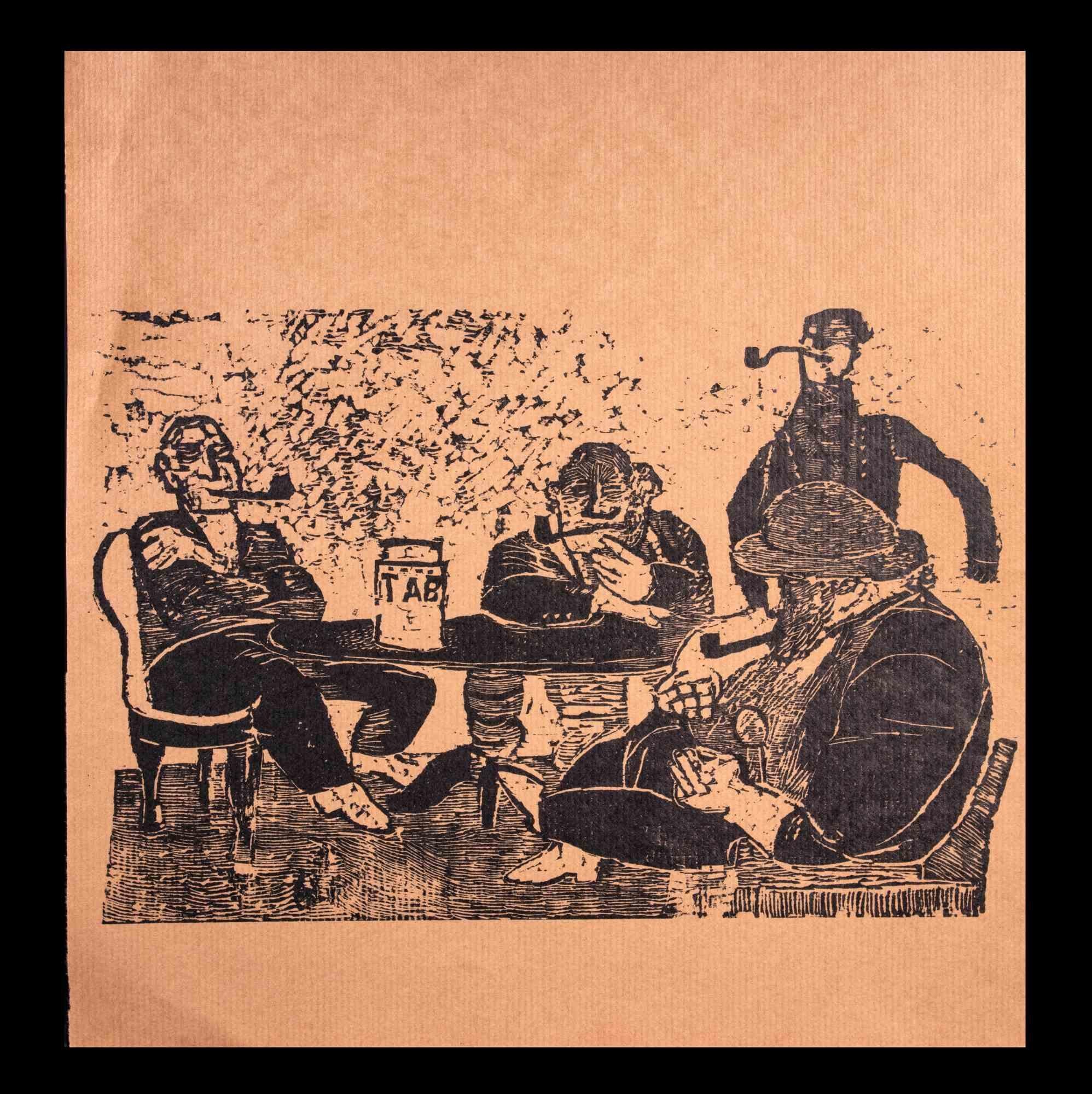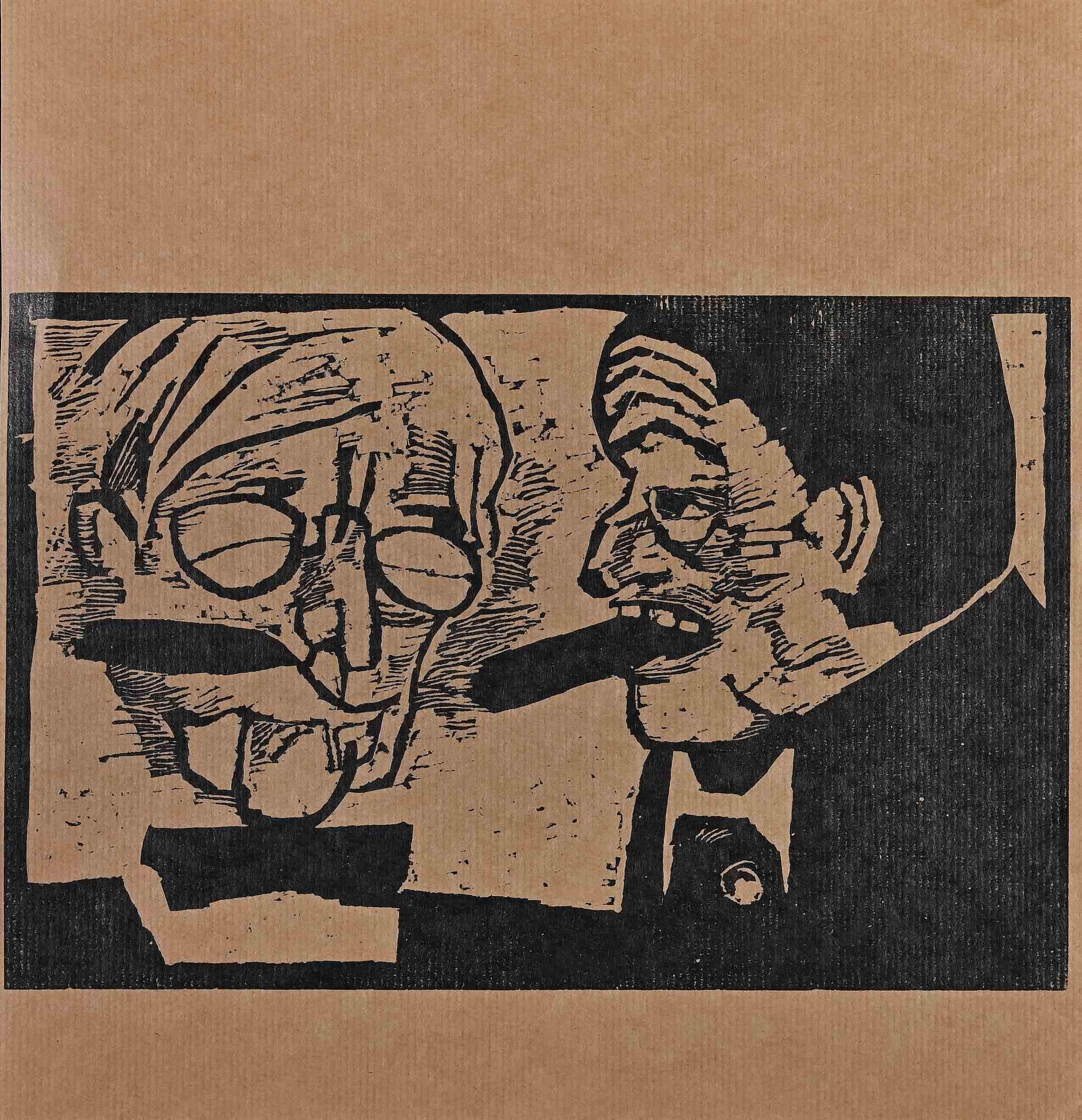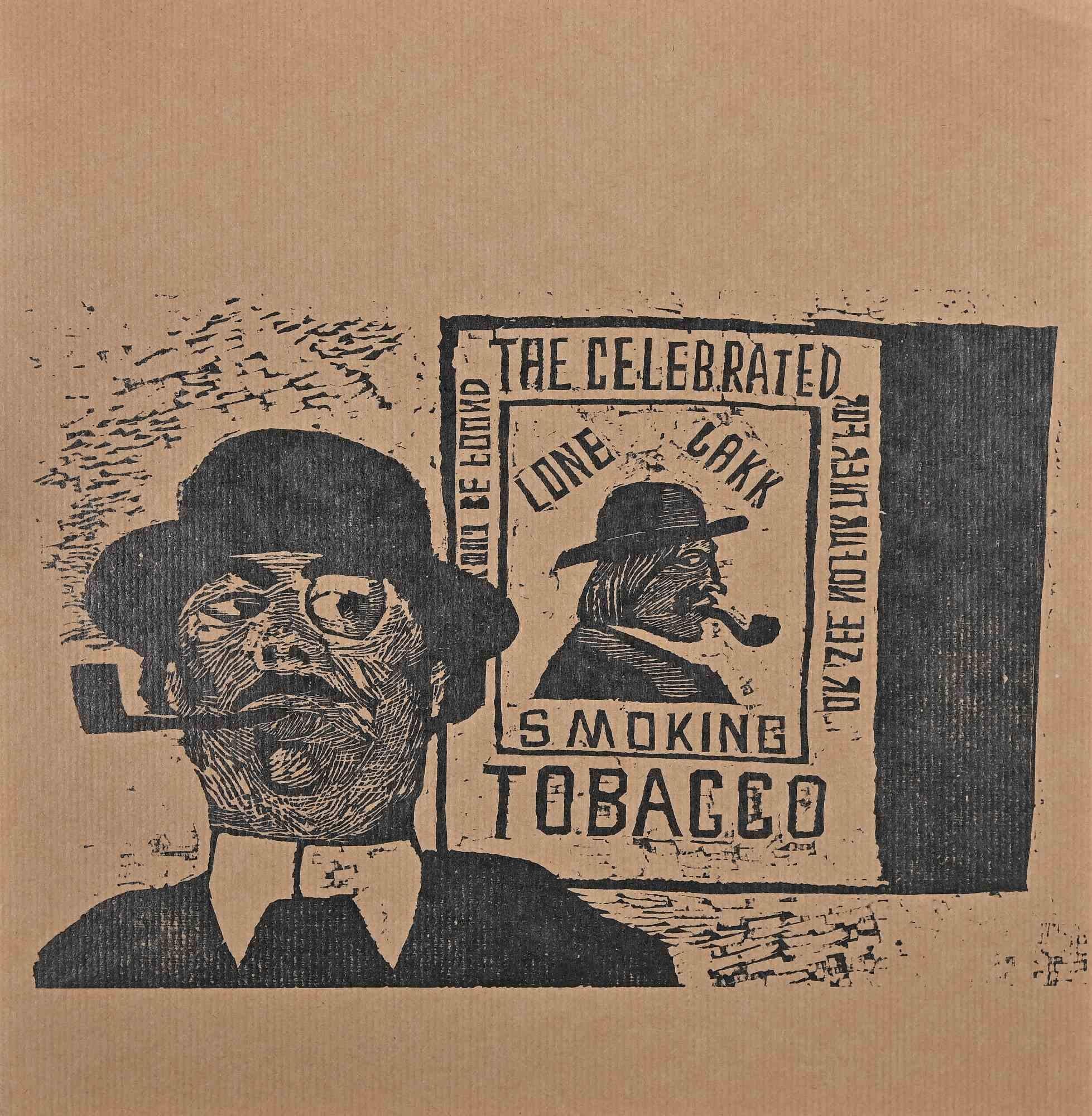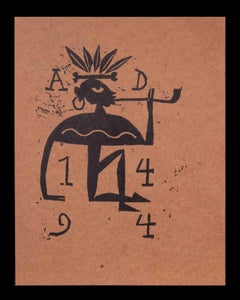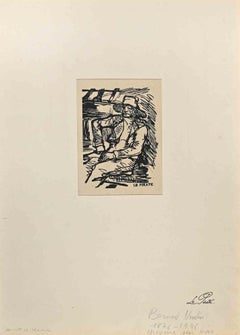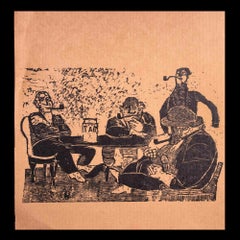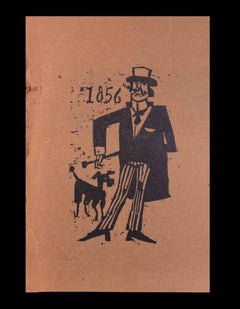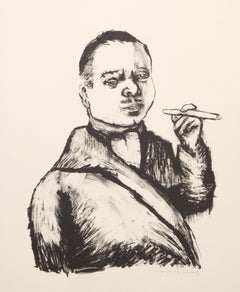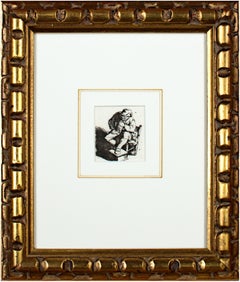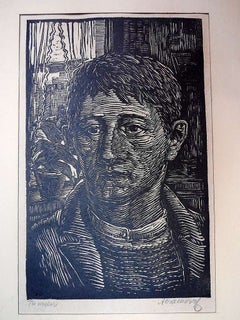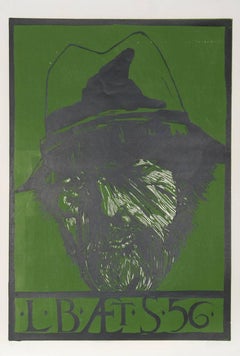Items Similar to The Smoker - Woodcut realized by Charles Dubin - Early 20th Century
Want more images or videos?
Request additional images or videos from the seller
1 of 2
Charles DubinThe Smoker - Woodcut realized by Charles Dubin - Early 20th CenturyEarly 20th Century
Early 20th Century
$302
£228.07
€255.32
CA$422.37
A$461.99
CHF 242.44
MX$5,525.17
NOK 3,059.60
SEK 2,854.24
DKK 1,944.91
About the Item
The Smoker is an original woodcut print, realized by Charles Dubin in the 20th Century. The artist was active in the period between 1920 ca. and 1955 ca.
The artwork is hand-signed on the lower left . Numbered on the lower right, the edition of 2/125 prints. Passepartout cm 48x34
The representation is in the foreground, a portrait of a silent man. The composition is harmonious and the colours are strong and marked.
- Creator:Charles Dubin
- Creation Year:Early 20th Century
- Dimensions:Height: 13 in (33 cm)Width: 10.04 in (25.5 cm)Depth: 0.4 in (1 cm)
- Medium:
- Movement & Style:
- Period:
- Condition:Insurance may be requested by customers as additional service, contact us for more information.
- Gallery Location:Roma, IT
- Reference Number:Seller: T-1305081stDibs: LU65039964422
About the Seller
4.9
Platinum Seller
Premium sellers with a 4.7+ rating and 24-hour response times
1stDibs seller since 2017
7,827 sales on 1stDibs
Typical response time: 1 hour
- ShippingRetrieving quote...Shipping from: Roma, Italy
- Return Policy
More From This Seller
View AllSmoking Tribal Man - Woodcut Print by Charles Sterns - Early 20th Century
Located in Roma, IT
Smoking Tribal Man is a woodcut on brownish color paper print on paper realized by Charles Sterns in the early 20th century
Very Good conditions.
The artwork is represented by mast...
Category
Early 20th Century Modern Figurative Prints
Materials
Woodcut
The Pirate - Original Woodcut Print by Bernard Naudin- Early 20th Century
Located in Roma, IT
The Pirate is an Original Woodcut print realized by Bernard Naudin (1876-1946).
The artwork is in good condition on a yellowed paper.
Hand-signed with pencil by the artist on the ...
Category
Early 20th Century Modern Figurative Prints
Materials
Woodcut
Men Who Smoke the Pipe - Original Woodcut print - Early 20th century
Located in Roma, IT
Men Who Smoke the Pipe is an original woodcut print realized by an unknown artist of early 20th century.
Good condition on a brown cardboard.
No Signature.
Category
Early 20th Century Modern Figurative Prints
Materials
Woodcut
Smoking Gentleman in 1856 - Woodcut print by Charles Sterns - Early 20th Century
Located in Roma, IT
Smoking Gentleman in 1856 is a woodcut print on brownish color paper print on paper realized by Charles Sterns in the early 20th century
Good conditions with a small cut on the marg...
Category
Early 20th Century Modern Figurative Prints
Materials
Woodcut
Men With Cigar - Woodcut - Early 20th Century
Located in Roma, IT
Men With Cigar is a woodcut print realized by an Anonymous artist in the early 20th Century.
Good condition.
The artwork is depicted through quick and expressive strokes in a well-...
Category
Early 20th Century Expressionist Figurative Prints
Materials
Woodcut
$227 Sale Price
20% Off
Figures - Woodcut Print by Charles Sterns - Early 20th Century
Located in Roma, IT
Figures is a woodcut print on paper realized by Charles Sterns in the Early 20th Century.
Good conditions.
The artwork is depicted through soft strokes in a well-balanced composition.
Category
Early 20th Century Modern Figurative Prints
Materials
Woodcut
You May Also Like
Man Smoking Cigar From The Midget and the Dwarf Portfolio, Surrealist Lithograph
Located in Long Island City, NY
Aubrey Schwartz, American (1928 - 2019) - Man Smoking Cigar From The Midget and the Dwarf Portfolio, Year: 1960, Medium: Lithograph on Arches, signed and numbered in pencil, Editio...
Category
1960s Surrealist Portrait Prints
Materials
Lithograph
'The Smoker (Le Fumeur)' original etching by Cornelis-Pietersz Bega
By Cornelis Bega
Located in Milwaukee, WI
'The Smoker (Le Fumeur)' is an original etching by the celebrated Dutch painter and printmaker Cornelis-Pietersz Bega. It presents a genre scene of the type Bega was best known for: Bega's principal subjects were genre representations of taverns, domestic interiors and villages. He depicted nursing mothers, prostitutes, drunks, gamblers and fools such as quack doctors and alchemists. In this case, he shows a man seated on a chair with his foot on a flat stool and holding a smoking pipe. For Bega, this representation was more of a caricature than it was an image of a specific person, and such genre scenes would have held allegorical and symbolic meaning for the seventeenth-century viewer. During the seventeenth century, the Dutch of all levels of society consumed tobacco and alcohol, and these were an important part of the Dutch economy and a major source of wealth. At the same time, however, moralists and ministers sought to curb intoxication: they openly described drinking and smoking as sinful, immoral, and a general threat to one’s reputation. This paradox is reflected in prints such as this, which inherently carry the national pride of the Dutch economy alongside a moral warning in a print that could be just as easily consumed and collected.
2.5 x 2.25 inches, print
12.38 x 10.38 inches, frame
Framed to conservation standards using archival materials including 100 percent rag matting and mounting materials. Housed in a gold finish Spanish-style wood moulding.
Overall good and stable condition; margins cut to plate; some wrinkling in the corners from previous mounting; housed in a new custom frame.
Cornelis Bega was born into prosperous circumstances. His mother, Maria Cornelis, inherited half the estate (gold, silver, paintings, drawings and prints) and all of the red chalk drawings of her father, Cornelis Cornelisz van Haarlem, a renowned Mannerist artist. Bega's father was Pieter Jansz Begijn (d 1648), a gold and silversmith.
Like other family members, Bega was probably Catholic. Houbraken's claim that Bega studied with Adriaen van Ostade is likely to be correct; this was probably before 24 April 1653, when Bega joined Vincent Laurentsz. van der Vinne in Frankfurt for a journey through Germany, Switzerland and France. Bega had returned to Haarlem by 1 September 1654, at which time he joined the Guild of St Luke; he was already a competent draughtsman, as indicated by his first extant dated work, Interior with a Nursing Mother (1652; Frankfurt am Main, Städel. Kstinst.), and by a remarkable double portrait (Amsterdam, Rijksmuseum) drawn by him and Leendert van der Cooghen in 1654.
Bega painted, drew, etched and made counterproofs in a wide variety of materials on different types of small-scale supports. He may have been the first Dutch artist to make monotypes, but this remains controversial. Approximately 160 paintings, 80 drawings and six monotypes by Bega have been catalogued, as well as around 34 etchings.
Bega's principal subjects were genre representations of taverns, domestic interiors and villages. He depicted nursing mothers, prostitutes, drunks, smokers, gamblers and fools such as quack doctors and alchemists. Less common subjects include the ridiculed or pestered woman, as in Two Figures and Mother with a Spirits Bottle (c. 1662; Gouda, Stedel, Museum Catharina Gasthuis) and The Inn (etching), as well as witty satires on traditional scenes of middle-class music-makers, such as the Music Lesson (1663; Paris, Petit Palace).
Bega's early paintings, such as the Weaver's Family (c. 1652; St Petersburg, Hermitage), are freely executed, dark and coarse, recalling the many-figured peasant subjects of van Ostade. Between c. 1660 and 1664 he began to paint genre scenes with fewer figures, which are finely articulated, colourful and psychologically expressive, for example Two Men Singing (1662; Dublin, N.G.). His exquisite, late fijnschilderen ('fine painting') manner, evident in The Alchemist (1663; Malibu, Getty Museum), compares well with that of Gerrit Dou.
As a draughtsman Bega is noted for his single-figure studies, executed mainly in black and white chalk on blue paper or red chalk on white paper. None of the studies, which were drawn naer het leven (from life), seem to relate to a painting or etching. Bega traded drawings or shared models with other artists of the Haarlem school, including van der Cooghen, Gerrit Berckheyde, Dirck Helmbreker and Cornelis Visscher. These artists drew chalk figure studies in a very similar style, characterised by regular and precise parallel shading and well-defined forms; their drawings, especially those of Bega and Berckheyde, have been frequently confused. Unlike the realistic figure studies, Bega's etchings depict interiors with figures or single figures in the manner of van Ostade; the compositions, often with masterful chiaroscuro effects, reflect most closely the paintings of the 1650s.
Bega is likely to have remained in Haarlem, where he paid dues to the Guild in 1661. He probably died from the plague; fees for his expensive funeral at St. Bavo's were paid on 30 August 1664. Among the artists he influenced were Thomas Wijck, Jan Steen, Richard Brakenburg (1650-1702) and Cornelis Dusart. Painters such as R. Oostrzaen ( fl ?1656) and Jacob Toorenvliet...
Category
17th Century Old Masters Figurative Prints
Materials
Paper, Etching
WPA Expressionist woodblock print. "The Worker"
By Albert Abramovitz
Located in Surfside, FL
Pencil signed original limited edition woodcut woodblock print great depression era. from the 1930s.
Abramovitz, Albert 1879-1963
Born in Riga, Latvia, Abramovitz studied art at th...
Category
1930s Portrait Prints
Materials
Woodcut
Self Portrait, Surrealist Woodcut by Leonard Baskin 1956
By Leonard Baskin
Located in Long Island City, NY
Artist: Leonard Baskin
Title: Self Portrait - "L.B. AE T. S"
Year: 1956
Medium: Woodcut, Signed and Numbered in pencil
Edition: 150
Size: 35.5 x 24 inches
Category
1950s Surrealist Portrait Prints
Materials
Woodcut
Victor Rebuffo (1903-1983) - Mid 20th Century Woodcut, Portuario
Located in Corsham, GB
An original woodcut print by the listed Italian-Argentinian artist Victor Luciano Rebuffo (1903-1983). Entitled 'Portuario'. The print depicts a figure, likely a dockworker. Monogram...
Category
20th Century Portrait Prints
Materials
Woodcut
Don Quixote de La Mancha: Signed Limited Edition Woodcut Portrait by De Groat
Located in Alamo, CA
A limited edition woodcut portrait of Don Quixote de la Marcha by George De Groat (1917-1995). Don Quixote is instantly recognizable due to his thin fa...
Category
Late 20th Century American Modern Portrait Prints
Materials
Woodcut
$1,260 Sale Price
20% Off
More Ways To Browse
Vintage Smokers
19th Century Etchings
Prints Of 18th Century Paintings
Underwater Photography
Miro Lithographs
Photos Of Artists
Vintage Book Illustrations
German Print Early 20th Century
Germany Prints Early 20th Century
Art Sculptures Pop Art
Acrylic Mid Century Paintings
Men Black And White Photography
Marc Chagall Lithograph
New York 1980s Street Art
Georges Pompidou
Black And White Nude Females
Modern Art On Handmade Paper
Set Of 12 Framed Prints
